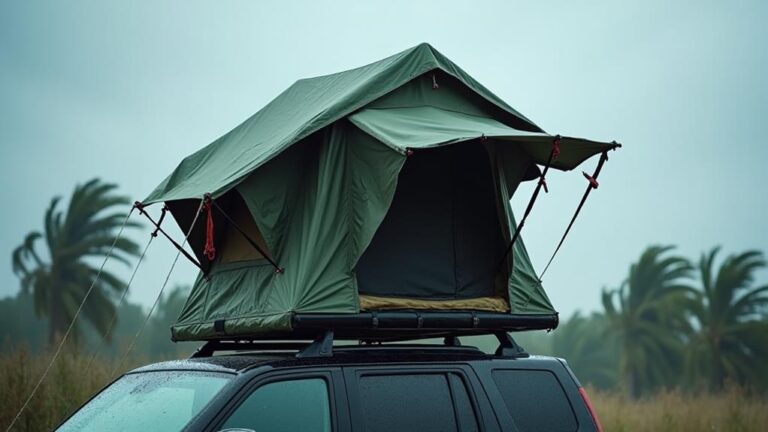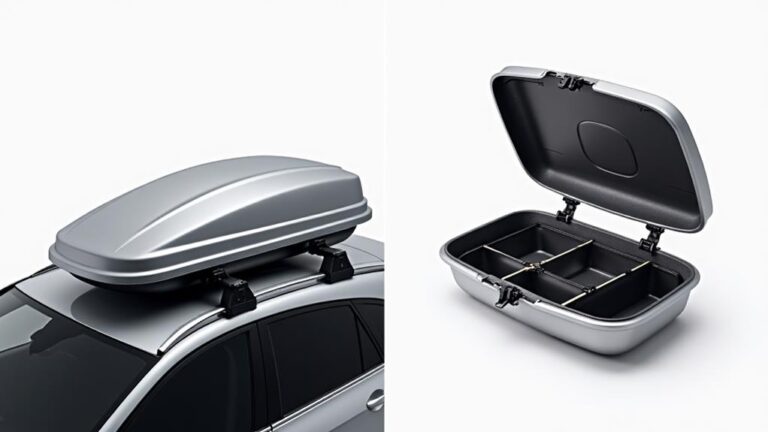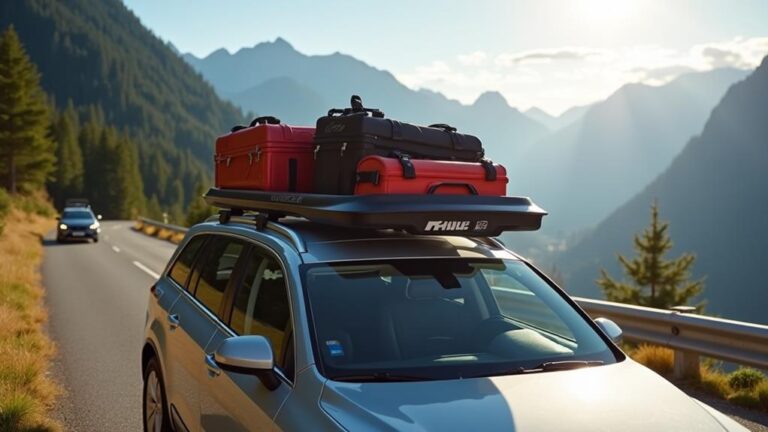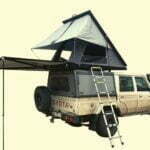According to research, over 70% of roof top tent owners experience flapping issues in windy conditions, which can significantly impact the overall camping experience. You're likely one of them, wondering how to prevent the noise and stress that comes with a flapping tent. If you've struggled with a roof top tent that can't seem to stay put, you're not alone. The solution lies in understanding the causes of the flapping and taking proactive steps to address them. What if a few simple adjustments and additions could transform your camping experience – and we're about to explore exactly that.
Key Takeaways
- Inspect the tent's condition, looking for signs of wear and tear, and perform regular maintenance to prevent flapping issues.
- Secure the tent to the vehicle using sturdy anchor points, metal loops, or D-rings, and consider using a roof top stabilizer.
- Adjust the tent fabric and rain fly's tension to minimize flapping, using a star pattern tightening technique and additional straps if needed.
- Employ anti-flap devices, such as wind deflectors or clamp systems, to redirect airflow and hold the tent firmly in place.
- Add weight to the tent by using heavy sleeping bags, gear, or weights to lower the center of gravity and alleviate flapping.
Assessing Your Roof Top Tent
Assessing your roof top tent is the first step in stopping the flapping issue.
You'll need to inspect the tent's condition and identify potential causes of the problem. Start by checking the fabric for any signs of wear, such as tears, holes, or frayed edges.
Look for loose threads or stitching that could be contributing to the flapping.
Next, inspect the tent's attachment points to the roof rack.
Ensure that all bolts, nuts, and screws are securely tightened. Check the condition of the rubber seals and gaskets, as these can deteriorate over time and allow wind to enter the tent.
Regular tent maintenance is essential to prevent flapping issues.
Check your tent's manual for recommended maintenance schedules. Clean the tent regularly to prevent dirt and debris from accumulating and causing damage.
Apply a waterproof coating to the fabric to protect it from the elements.
Choosing the Right Anchor Points
When setting up your roof top tent, the anchor points you choose can greatly impact its stability and minimize flapping.
The key is to select points that provide a solid base for your tent anchors, ensuring a stronger attachment to your vehicle or trailer.
Look for metal loops, hooks, or D-rings that are specifically designed for tent attachment.
These points should be sturdy, securely attached to your vehicle, and able to withstand strong winds.
Avoid using weak or loose points, as they can compromise the stability of your tent.
Additionally, consider the type of tent anchors you're using.
Look for anchors with a wide, sturdy base that can distribute the force of the wind evenly.
These anchors will provide a stronger attachment to your vehicle and reduce the risk of flapping.
Some roof top tents come with anchor points or attachment systems specifically designed for the tent.
If this is the case, use these points to ensure a secure and stable setup.
Tightening the Tent Fabric
Most roof top tents are designed with adjustable fabric tension systems, allowing you to fine-tune the tightness of the fabric to minimize flapping.
To tighten the tent fabric effectively, start by checking the manufacturer's instructions for specific tightening techniques. Typically, you'll need to locate the adjustable tension straps or clips that hold the fabric in place.
Look for any loose or sagging areas and make the necessary fabric adjustments.
Begin by tightening the straps or clips in small increments, working your way around the tent to maintain even tension. Be careful not to over-tighten, as this can put excessive stress on the fabric and the tent's frame.
Use a tightening technique that involves tightening in a star pattern, where you alternate between tightening straps on opposite sides of the tent.
This helps to distribute the tension evenly and prevents the fabric from becoming misshapen. By making these adjustments and using the right tightening techniques, you can significantly reduce the flapping and noise associated with your roof top tent.
Using Anti Flap Devices
When you're looking to prevent roof top tent flapping, using anti flap devices can be an effective solution.
You'll find various types of devices available on the market, including anti-flap kits that can be installed on your tent to minimize fabric movement.
Types of Devices
To combat the issue of roof top tent flapping, you can employ various anti-flap devices designed to minimize or eliminate this problem.
These devices work by either reducing the wind's force on the tent or by holding the tent's fabric in place. One common type of anti-flap device is wind deflectors, which redirect airflow around the tent, reducing the pressure that causes flapping.
These deflectors can be mounted on the roof rack or the tent's frame and come in different shapes and sizes.
Clamp systems are another type of anti-flap device that can be used to secure your roof top tent.
These systems consist of clamps that attach to the tent's fabric and the roof rack, holding the tent firmly in place. Clamp systems can be adjusted to fit different types of tents and roof racks, making them a versatile option.
They can also be used in combination with wind deflectors for added stability. By choosing the right anti-flap device for your roof top tent, you can enjoy a more peaceful camping experience, even in windy conditions.
Installing Anti-Flap Kits
You've chosen an anti-flap device to minimize roof top tent flapping, and now it's time to install it. Before you start, make sure you have all the necessary components, including the anti-flap kit, mounting hardware, and any additional tools required for the installation.
Kit Comparison and Installation Tips
| Anti-Flap Kit | Installation Tips |
|---|---|
| Standard Kit | Mount the anti-flap device to the roof top tent's rain fly or side panels using the provided hardware. Ensure the device is securely attached to withstand strong winds. |
| Deluxe Kit | Use the included straps or clips to attach the anti-flap device to the roof top tent's frame or support bars. Tighten the straps or clips firmly to prevent the device from coming loose. |
| Custom Kit | Consult the manufacturer's instructions for specific installation requirements. Use the provided templates or patterns to ensure accurate placement of the anti-flap device. |
When installing the anti-flap kit, follow the manufacturer's instructions and take your time to ensure a secure and proper installation. A well-installed anti-flap device can significantly reduce roof top tent flapping and improve your camping experience.
Securing the Rain Fly
To secure your rain fly effectively, you'll need to focus on three key areas: adjusting the fly tension, using additional straps, and tightening the fly clips.
Properly adjusting the rain fly's tension is crucial to prevent flapping and ensure a tight seal.
Adjusting Fly Tension
A well-tensioned fly is crucial for securing the rain fly and preventing unwanted flapping of your roof top tent.
When it comes to adjusting fly tension, you'll need to optimize the tension to ensure a snug fit. Check the manufacturer's instructions for specific guidance on fly adjustment, but generally, you'll want to start by tightening the fly's attachment points to the tent's frame.
Next, inspect the fly's fabric and adjust the tension accordingly.
If the fabric is loose or saggy, tighten the straps or clips. Conversely, if the fabric is too tight, loosen the straps. Tension optimization is key here – you want the fly to be taut, but not so tight that it restricts airflow or causes the tent's frame to flex.
As you adjust the fly's tension, check for any wrinkles or creases in the fabric.
These can create weak points that allow wind to penetrate and cause flapping. By optimizing the fly's tension and eliminating wrinkles, you'll significantly reduce the likelihood of unwanted flapping and ensure a more secure and comfortable camping experience.
Using Additional Straps
When securing the rain fly, do additional straps offer a viable solution for stopping roof top tent flapping? In many cases, the answer is yes.
By adding extra straps to your roof top tent's rain fly, you can significantly reduce flapping caused by wind. This method is particularly effective when used in conjunction with proper fly tension adjustment.
To get the most out of additional straps, focus on strategic strap placement and reinforcement.
- Position straps at the fly's pressure points, such as the center and corners, where wind force is most concentrated.
- Use straps with a secure buckle system, ensuring they won't come loose over time or in harsh weather conditions.
- Keep straps taut but not over-tightened, allowing for some flexibility to absorb wind gusts without damaging the tent or straps.
Tightening Fly Clips
While securing the rain fly is crucial in stopping roof top tent flapping, tightening fly clips is often overlooked as a vital step in this process.
To ensure your clips are functioning correctly, you'll need to perform regular clip maintenance. Start by conducting a thorough clip inspection to identify any damaged or worn-out clips.
Check for signs of wear, such as rust, corrosion, or bent metal. If you find any damaged clips, replace them immediately.
Next, inspect the clip's tensioning mechanism. If it's loose or damaged, tighten or replace it according to the manufacturer's instructions.
Tightening fly clips is straightforward. Simply locate the clips that secure the rain fly to the tent's frame and turn the tensioning knob clockwise until they're snug.
Be careful not to overtighten, as this can damage the clips or the rain fly. Repeat this process for all clips, ensuring they're evenly tensioned.
Regular clip maintenance and tightening will help prevent roof top tent flapping and ensure a secure, watertight seal. By doing so, you'll enjoy a more comfortable and peaceful camping experience.
Adding Weight to the Tent
On top of securing your roof top tent with proper tie-downs and guylines, adding weight to the tent itself can help alleviate flapping.
This is because the added weight lowers the center gravity of the tent, making it more stable and less prone to movement caused by wind.
Proper weight distribution is crucial, as it ensures that the weight is evenly spread across the tent, preventing it from shifting or tilting in strong winds.
To effectively add weight to your roof top tent, consider the following:
- Use heavy sleeping bags, clothing, or gear to weigh down the tent's sleeping area.
- Place weights, such as water jugs or heavy tools, in the tent's corners or along its edges.
- Install a storage rack or shelf system inside the tent to hold heavy gear and distribute weight evenly.
Selecting a Windproof Design
How can you minimize wind-induced flapping and maximize the performance of your roof top tent? When selecting a windproof design, consider the results of wind tunnel testing and look for aerodynamic shapes. These design elements will reduce the impact of wind on your tent.
| Design Features | Wind Resistance | Noise Reduction |
|---|---|---|
| Aerodynamic profiles | High | High |
| Smooth, rounded edges | Medium | Medium |
| Angular, boxy shapes | Low | Low |
| Textured, irregular surfaces | Low | Low |
Aerodynamic shapes can significantly reduce wind resistance, minimizing the stress on your roof top tent. Look for designs with smooth, rounded edges and profiles that have been optimized for wind resistance. Avoid angular, boxy shapes and textured, irregular surfaces, as they can increase wind resistance and noise. By selecting a windproof design, you can enjoy a more peaceful and secure camping experience. When shopping for a roof top tent, prioritize designs that have undergone wind tunnel testing and incorporate aerodynamic shapes. This will help you minimize wind-induced flapping and maximize the performance of your tent.
Installing a Roof Top Stabilizer
A well-designed roof top tent can go a long way in minimizing wind-induced flapping, but it's just one part of the equation.
Installing a Roof Top Stabilizer is another crucial step to ensure a secure and quiet camping experience. A Roof Top Stabilizer is a device that attaches to your roof top tent and vehicle, providing additional support and stability in windy conditions.
The Stabilizer Benefits are numerous.
By installing a Roof Top Stabilizer, you can:
- Reduce wind-induced stress on your roof top tent, extending its lifespan
- Minimize noise and vibrations caused by flapping fabric
- Enhance overall safety by securing your tent and preventing accidental detachments
When selecting a Roof Top Stabilizer, consider the type of roof top tent you have, as well as the vehicle's make and model.
Look for a stabilizer that's specifically designed for your setup, and follow the manufacturer's instructions for installation. Proper installation is key to ensuring the effectiveness of the stabilizer and preventing damage to your vehicle or tent.
With a Roof Top Stabilizer in place, you can enjoy a more peaceful and secure camping experience, even in windy conditions.
Frequently Asked Questions
Can I Use Rocks to Weigh Down My Roof Top Tent?
You can use rocks to add weight, but consider proper rock placement and weight distribution. Ensure they're evenly spaced and centered to prevent shifting, and use a tarp or cloth to protect your gear from damage.
Is It Safe to Drive With an Erect Roof Top Tent?
You're considering driving with an erect roof top tent, but it's crucial to assess wind resistance and tent aerodynamics first. Elevated tents can disrupt airflow, increasing the risk of instability and potentially compromising your vehicle's safety.
How Often Should I Inspect My Roof Top Tent?
You'll likely inspect your roof top tent's weather resistance after each trip, but theory suggests that regular, in-depth checks – every 3-6 months – are crucial for optimal tent maintenance and extended lifespan.
Can I Use a Roof Top Tent in Extreme Weather?
You should check your roof top tent's weather resistance and storm preparedness before using it in extreme conditions. Ensure it's designed for heavy rain, strong winds, and hail, to guarantee your safety and comfort outdoors.
Are Roof Top Stabilizers Compatible With All Tents?
You'll find that roof top stabilizers are generally compatible with most tents, but you should check with the tent manufacturer for specific requirements, as stabilizer materials and designs can vary greatly.
Conclusion
As a seasoned adventurer, you've weathered the storm, and now your roof top tent stands firm, like the unsinkable Titanic before the iceberg. But unlike the ill-fated ship, your tent's stability isn't just a myth. By following these steps, you've secured your tent and outsmarted the wind. The roar of the gusts is now just a gentle hum, a reminder of the storm you've conquered. Your roof top tent is no longer a flapping liability, but a cozy refuge.












